Reading between the slices: What is the "Pentagon Pizza Index"?
Also known as the Pizza Meter, this phenomenon tracks unusual takeout activity near U.S. government hubs like the Pentagon, CIA, and White House, often observed just hours before global emergencies unfold.
ADVERTISEMENT
When the smell of pizza fills the halls of the Pentagon, some believe the world might be on the brink of crisis.
Dubbed the Pentagon Pizza Index, this quirky-yet-creepy theory suggests that sudden spikes in food delivery orders - not just pizza - to top U.S. intelligence agencies may signal major global developments before they're publicly announced.
What is the Pentagon Pizza Index?
Also known as the Pizza Meter, this phenomenon tracks unusual takeout activity near U.S. government hubs like the Pentagon, CIA, and White House, often observed just hours before global emergencies unfold.
The pattern is simple: When high-level officials stay late at work - possibly preparing for war, a coup, or an international incident - they tend to order in. And when they do, it shows up in the data.
This data isn't classified. It's visible through Google Maps' "busy" hours, Uber Eats footfall trends, and even on-the-ground reports from nearby bars or eateries that suddenly become quiet, according to media reports.
A Slice of History: Cold War origins
The theory isn't just online speculation. It originated in the late Cold War era, when Frank Meeks, a Domino's franchisee in Northern Virginia, noticed a curious trend.
On the eve of key national security events, pizza orders to government buildings doubled.
- October 1983: Orders surged the night before the U.S. invaded Grenada.
- December 1989: It happened again before the invasion of Panama.
- August 1, 1990: The CIA ordered 21 pizzas right before Iraq's invasion of Kuwait - a record at that time.
- December 1998: Pizza demand jumped during Bill Clinton's impeachment hearings and U.S. military operations in Kosovo.
Modern tracking: OSINT meets Mozzarellla
In 2024 and 2025, the Pizza Index took on new life, thanks to open-source intelligence (OSINT). With apps like Google Maps and X, people are now watching Domino's delivery zones the way others monitor satellite imagery.
One X account, @PenPizzaReport, has become a go-to source for tracking "abnormal" pizza activity. On June 1, 2025, it flagged a spike in orders near the Pentagon. Hours later, news broke of an Israeli strike on Iranian targets - a potential precursor to wider escalation.
The same trend was spotted on April 13, 2024, when Iran launched drones at Israel in retaliation for an attack on its consulate. Before the news broke, pizza deliveries near D.C. surged again.
Why Pizza?
It's not just coincidence. During high-stress situations, staff are often stuck in 16-20 hour shifts. Pizza is inexpensive, filling, and delivers well, making it the go-to choice for crisis-fuelled overtime meals.
As per reports, Behavioural Psychology backs this up: Under stress, people tend to crave calorie-dense comfort food. When dozens of staffers order from the same restaurant, it causes noticeable traffic that even casual observers - or algorithms - can detect.
Is it Reliable?
Not exactly. The Pizza Index isn't infallible. It might pick up on late work nights, nearby football games, or food app glitches. That's why modern OSNIT sleuths cross-check pizza patterns with:
- Military aircraft activity
- Ride-hailing trends
- Local electricity usage
- Police scanner activity
What the Government Says
Officially? Nothing. U.S. authorities have never commented on the Pizza Index or its implications, reports suggest. But for digital watchdogs and online conspiracy theorists alike, it remains an oddly consistent - and darkly humorous - proxy for preparedness.
So, next time you see the Pentagon's neighbourhood pizzerias lighting up late at night - you might want to refresh your news feed. Something big might be cooking.

